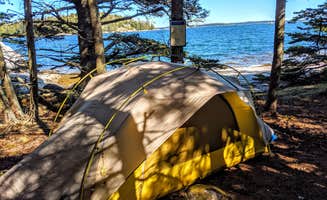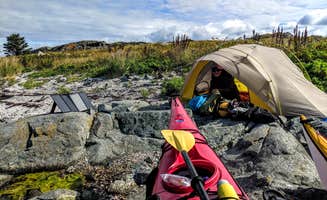Dispersed camping near Damariscotta, Maine requires careful planning, especially for water access areas. The Deer Isle Archipelago sites experience significant tidal fluctuations that can vary by 8-10 feet between high and low tide. Weather conditions change rapidly in this region, with fog often rolling in unexpectedly even during summer months. Maine's island camping regulations prohibit groups larger than 6 people per site in most locations.
What to do
Island exploration: Wheat Island serves as an excellent base for exploring the remote sections of Acadia National Park. "Perfect island for exploring the close-by Isle au Haut, a remote section of Acadia National Park, but very hard to get reservations at Duck Harbor Campground," notes reviewer Shari G. about Wheat Island.
Beach combing: The shorelines of these islands offer unique opportunities to discover marine life and natural treasures. Doliver Island features a "gorgeous shell covered beach and a beautiful view of Isle au Haut, just next door," according to camping reviews.
Kayaking: The archipelago provides numerous paddling routes between islands. Buckle Island is particularly suitable for novice paddlers as it has "sandy shore, which is exposed for a good portion of the day, is easy to land on and a short walk to a trail into the woods," making it ideal for Buckle Island campers new to sea kayaking.
What campers like
Sunset viewing: Island camping provides unobstructed western views. Campers at Wheat Island particularly enjoy the larger southwest site that offers "a gorgeous view of the sun setting and full moon rising," creating memorable evening experiences.
Solitude: The limited access nature of these sites ensures privacy. Doliver Island is notably small with "barely a tent space, but a good stop for us on our 9 day journey and a perfect launching spot for crossing Jericho Bay (4.5 miles) to Marshall Island the next day."
Wildlife observation: The islands host diverse bird populations and marine mammals. Campers regularly report sightings of seals, porpoises, and various seabirds throughout the archipelago, especially during morning hours.
What you should know
Water planning: No freshwater sources exist on any islands. All camping locations require carrying sufficient drinking water for the entire stay plus emergency reserves. As one Buckle Island camper advises, "Come prepared with fresh water (there is no fresh water for filtering) and wag bags (no toilets)."
Membership requirements: Island access requires affiliation with specific organizations. "Sites are first come, first served and completely free for MITA members," explains a review from Wheat Island, referring to the Maine Island Trail Association membership needed for legal camping.
Landing conditions: Tidal schedules significantly impact arrival and departure options. Doliver Island "can be a tricky island to land on at high tide, so plan accordingly," requiring paddlers to time arrivals during favorable tidal conditions.
Tips for camping with families
Site selection: Choose islands with more forgiving landing areas. Buckle Island provides "a perfect island for those new to sea kayak camping as the sandy shore, which is exposed for a good portion of the day, is easy to land on," making it safer for family groups with children.
Insect protection: Bring appropriate repellents regardless of season. Island campers report that "we thought we were passed mosquito season in early September, but alas, they were pretty bad at sunset," highlighting the need for consistent protection measures.
Communication planning: Cell service remains unreliable throughout the archipelago. Families should bring marine radios and establish clear emergency protocols before departing for these remote dispersed camping locations near Damariscotta.
Tips from RVers
Mainland staging: No RV accommodations exist on the islands, but nearby mainland areas offer staging options. Utilize mainland campgrounds as base camps for day trips, ensuring secure parking while exploring the islands by watercraft.
Kayak transportation: Special considerations apply when bringing kayaks from distant locations. RVers recommend using proper roof racks and conducting thorough equipment checks before arriving at launch points due to limited repair options in the area.




